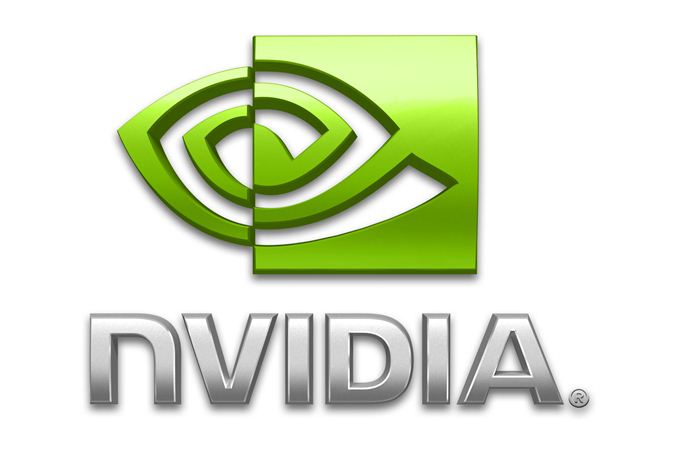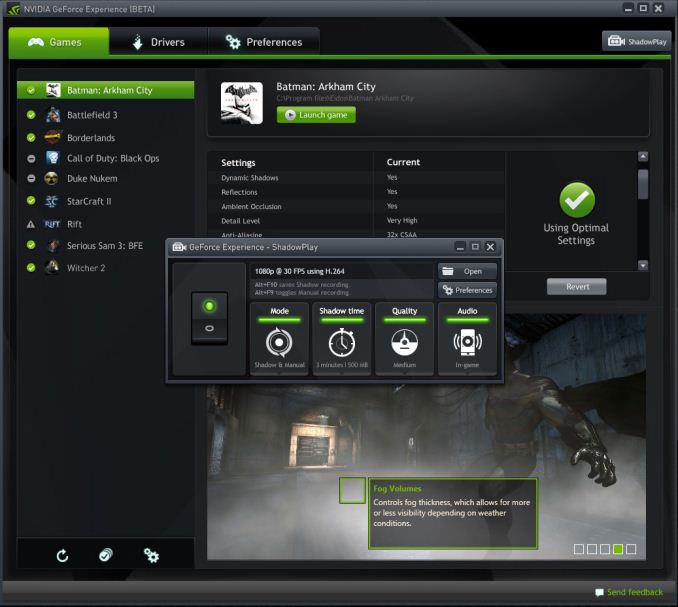GeForce ShadowPlay Gets a Beta Date & Twitch Support
by Ryan Smith on October 18, 2013 12:30 PM EST
As part of their Montreal game showcase announcements, NVIDIA has announced that their GeForce ShadowPlay feature will finally be getting a beta release date - October 28th - along with some additional game streaming functionality beyond what was initially announced.
ShadowPlay, as you may recall, is NVIDIA’s hardware encoding enabled video recording utility that’s part of their GeForce Experience software utility. ShadowPlay was first announced back at the launch of the GTX 780 in May, and is intended to be NVIDIA’s take on video recording while leveraging their NVENC hardware H.264 encoder. By using their hardware encoder as opposed to software encoding as is almost always the case on existing utilities, the overhead from recording should be significantly reduced, thereby making recording a nearly free operation. NVIDIA’s goal is to support both traditional recording and a 20 minute always-on rolling window recording, to capture and save footage after the fact. Video recording in this manner has always been something of an obvious use of the technology at hand, but ultimately it’s not something that anyone has seriously attempted at implementing until now.
Moving on, along with the previously planned recording features the release version of ShadowPlay will also be receiving some additional game streaming features that have been added in the interim. Twich.tv support is being integrated into the client, allowing ShadowPlay to be used to broadcast to the popular game streaming service. Like video recording software in general, Twitch clients are primarily software driven, so the idea here is to leverage ShadowPlay and the NVENC hardware to offer Twitch streaming without the heavy overhead those clients incur. Their ShadowPlay implementation should be fast enough, NVIDIA tells us, that it will have no problem streaming out to Twitch at 60fps while still keeping the impact to the recording PC minimal.
The beta for the initial version of ShadowPlay will be released on October 28th, which happens to coincide with the launch of the company’s holiday game bundles. NVIDIA is not committing to a release on the Twitch functionality however, so all indications right now are that it won’t be in the initial version. As always we’ll have more details on the client once it’s closer to launch.
On a side note, as our regular readers are aware this release is months later than NVIDIA originally planned, as ShadowPlay was originally intended to be released over the summer. However the client ended up being delayed after NVIDIA realized that their initial plans to use M2TS container files would be problematic due to the fact that the container format isn’t well supported by 3rd party software, particularly Windows Media Player. As a result the company has gone back to the drawing board and changed the client to use the more ubiquitous MP4 container format, which will bring with it much greater compatibility at the cost of delaying the client in order to implement the necessary changes.
Source: NVIDIA












12 Comments
View All Comments
xTRICKYxx - Friday, October 18, 2013 - link
The performance gap between the GTX 780 and Titan are already close enough... I wonder if the 780 ti will be even more powerful.dragonsqrrl - Friday, October 18, 2013 - link
It could have the same number of SMX's enabled, except with 3GB of GDDR5 and 1/24 fp32. There's a 2 SMX gap between the GTX780 and Titan.Kevin G - Friday, October 18, 2013 - link
I think it would have been wiser to release ShadowPlay supporting M2ST on schedule and then add MP4 support later.keitaro - Friday, October 18, 2013 - link
is their ShadowPlay a built-in feature of their GeForce Experience platform or can it be installed as a separate component? At the moment, I installed the drivers w/o the Experience stuff. It'd be a shame if it's a built-in component of Experience.Ryan Smith - Friday, October 18, 2013 - link
It's part of GeForce Experience. GFE will be a one-stop shop for the game settings stuff, game streaming, and ShadowPlay.nathanddrews - Friday, October 18, 2013 - link
Do you know if it will allow asynchronous recording? (ex: play at variable-fps and record at 30fps, etc.) Or will it force the framerate of the recording speed?Ryan Smith - Friday, October 18, 2013 - link
The Twitch functionality has been demo'd with the game running at a higher framerate than the recording. I don't have any more information on the matter beyond that.imaheadcase - Friday, October 18, 2013 - link
Do you have to encode the video for the 20min sections, or is it encoded on-the-fy by the card? From my limited reading I heard that because its faster the quality sometimes suffers.Ryan Smith - Friday, October 18, 2013 - link
It's encoded on the fly using the NVENC H.264 encoder. There isn't an intermediate storage/encode step.The 20 minute rolling window is for the DVR function; when enabled it keeps the last 20 minutes of your gameplay buffered so that you can save it after the fact.
chizow - Friday, October 18, 2013 - link
Pretty cool, I'll have to check this out. FRAPs has always been very CPU resource and storage throughput intensive, so anything to streamline the process while maintaining quality will be welcomed. It should also save on encoding time since it sounds like it's encoding and writing to H.264 in real-time via NVENC hardware.